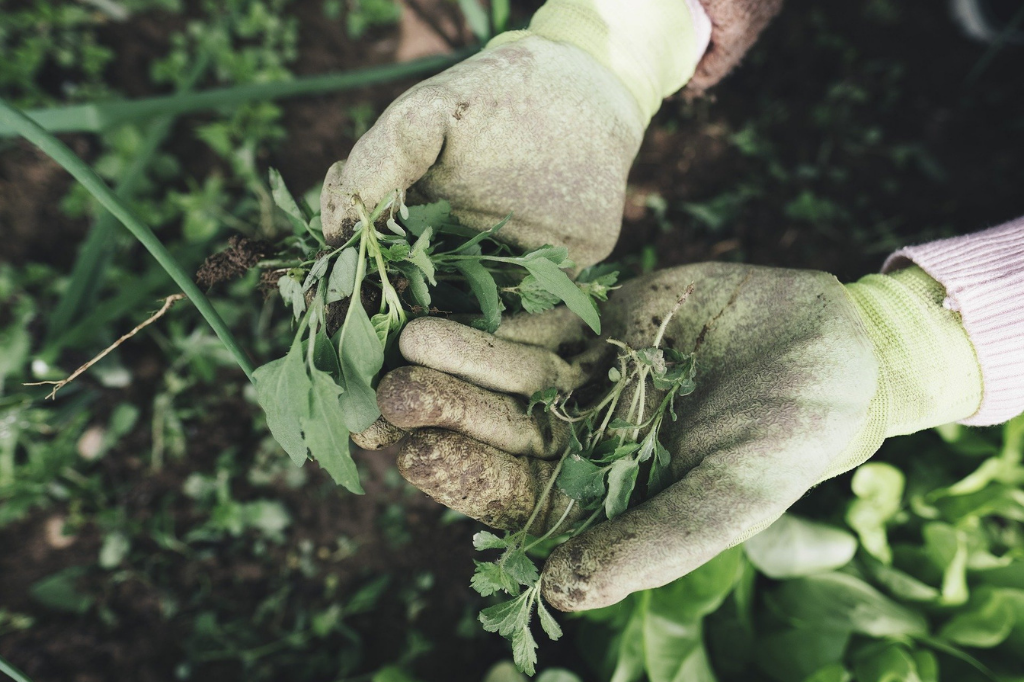Nine Tips to Get You Going
If you want to find out how to start an urban homestead, or if you’re just curious about what that could mean, you’ve come to the right place!
Here are nine things that we’re swearing by as we start our first year of Urban Homesteading.
1. Stack your Recipes

This may feel out of place at number one but it’s a great way to start incorporating so many aspects of urban homesteading into your day-to-day (and saving money) right from the start.
Reduce, Reuse, Recycle? Stack your recipes.
Learning food preservation? Stack your recipes.
Sustainable living? Stack your recipes!
When I say stack your recipes I’m talking about making your meals for the week so they build on one another. For example:
On Sunday: I roast a whole chicken with carrots, potatoes, and onion setting the vegetable scraps aside in the fridge. When my chicken is out of the oven I use the grease to make gravy.
Dinner is Roast chicken and Root Vegetables with Gravy
On Monday: I pick the chicken carcass of all its meat scraps and set them aside in the fridge. Then the carcass goes into a big pot along with the veggie scraps, covered with water, and left to simmer all day. Once it’s strained at the end of the night I have a chicken stock all ready to go for Tuesday.
Dinner is Monday’s leftovers with rice or noodles
On Tuesday: I make chicken soup with some more veggies, my chicken stock, and a third of the chicken I set aside in the fridge on Monday.
Dinner is Pozole
On Wednesday: I still have chicken meat in the fridge so I use another third for enchiladas, tacos, salad, or pasta.
Dinner is enchiladas, tacos, pasta, or salad with chicken
On Thursday: I have so many leftovers that I don’t cook at all.
Dinner is leftovers
On Friday: I use the last of my chicken meat and make enchiladas, tacos, salads, or pasta.
Dinner is enchiladas, tacos, pasta, or salad with chicken
That’s a lot of meals from one chicken!
By stacking recipes you’re able to get a lot more bang for your buck and you can feel good knowing that no part of the chicken went to waste.
Of course, you’re not going to have chicken every week. I don’t know about you but I think my house would revolt!
But aiming for one or two proteins a week that can be used multiple times is a great way to make full use of your ingredients and to start stretching your cooking skills – like learning to make gravies and stocks.
2. Compost

Even if you don’t have a garden going (yet) if you’ve got space for compost you can always find a use for compost.
From a large-scale multi-bin set up in your back yard to a worm bin you keep in your living room, composting can work for just about any living situation.
With so many different ways to compost, it can seem really intimidating to start – and that’s okay – composting is one of those things that you just have to dig into.
In the immortal words of Miss Frizzle “Take chances, make mistakes, and get messy!“
I recommend getting some books from your local library, perusing some pins on Pinterest, and giving YouTube a quick search then just dive-on-in and do it!
One of the nice things about compost is that it’s pretty forgiving. As long as you don’t add proteins or fats you probably won’t run into any issues you can’t fix – or ignore until next year (which is what happened to my first compost attempt, whoops, and it turned out okay!)
3. Garden

Gardening is probably the number one thing that people think of when they think about urban homesteading and for good reason!
Producing your own food is a pillar of the urban homesteading ethos and given the choice between starting with veggies or livestock, I think veggies are way less intimidating.
There are hundreds of ways to approach gardening and just like with composting there’s no one right way to do it, there’s just what’s best for you and a few cardinal things to avoid.
The three most popular gardening methods in the United States are
- Row Gardening – Planting in the ground with even rows of individual crops, think classic farm plot
- Container Gardening – Utilizing large pots, small pots, and window boxes to grow things when a yard isn’t available (or to maximize space)
- Raised Bed Gardening – Halfway between the two, raised bed gardening is a way to garden outdoors while also having more control over your soil composition and gaining some accessibility.
All three have pros and cons and I’d recommend looking into all of them before you pick which one is best for you.
Whatever system you use: don’t forget to water, don’t forget to harvest, and don’t forget to check your climate zone before planting.
4. Learn Food Preservation

If you’ve ever gardened before you know that a successful harvest is often an overwhelming harvest. If you aren’t planning to give away all that bounty (and eventually your friends do stop accepting tomatoes) then it’s time to start learning how to preserve food!
Canning, pickling, fermenting, freezing, salting, dehydrating, cold storage, the list goes on and on!
Different foods benefit from different methods and personal taste certainly influences which methods you’ll want to learn. I love vinegar so pickling okra and making kimchi are both high on my list.
On the other hand, if you don’t like the taste of vinegar then pickling may not be something you want to focus on so you could check out canning or dehydrating instead.
If you do decide to try your hand at preserving food just be sure you’ve followed all the instructions and that you know the signs to look for in case something goes wrong.
You don’t want to accidentally give yourself food poisoning!
5. Backyard Livestock

Chickens, ducks, rabbits, goats, quails, earthworms, and bees are all potential livestock options for your backyard.
Different places allow different things in residential areas so before getting too invested in that dream of fresh eggs every morning be sure to check local ordinances. This is doubly true if you’re a member of a homeowners association which likely has its own rules.
Once you know what your options are legally it’s time to start on the fun part and research what the best option is for you.
Some things to consider are
- how much time do you have to commit?
- how much experience do you have?
- what’s your budget like to start?
- how do your neighbors feel about it?
- Do you want meat? eggs? dairy? wool?
If you’re hoping to get bees it may be worth checking that none of your immediate neighbors are deathly allergic. Or if all of your neighbors are anti-chicken because of the noise concern consider going with quail instead.
You don’t need to have all your neighbors totally on board but having them be at least neutral to your little farmyard will save you some arguments later!
6. Sustainable Living

Sustainable Living is a bit of a catch-all for any lifestyle change that is more beneficial than harmful to the environment.
In some ways sustainable living is just the grown-up version of the reduce, reuse, recycle campaign that started in the 1970s.
Sustainable swaps to consider for your urban homestead include:
- Line drying clothing instead of using a gas or electric dryer
- Taking public transport instead of driving your own car
- Making your own cleaning supplies
- Mending clothes before replacing them
- Taking your own shopping bags to the grocery store
- Switching your Keurig for a french press or pour over
- Buying in bulk
- Cloth diapering instead of disposables
- and the list goes on!
Sustainable living is not an all-or-nothing decision.
The only thing you can do is your best and not all sustainable living suggestions are going to be a good fit for you or your family.
Just do what you can when you can and that’s enough.
7. Prioritize and Start Slow

It can be so easy to fall into that mindset trap of ‘if I don’t do it all RIGHT NOW I may as well not even start’ and I am here to tell you that is 110% your brain lying to you.
There is nothing in life that is easier if you do it all at once.
Think about it like this, if you wanted to learn to cook you wouldn’t go from not cooking at all to making three-course meals three times a day. It just isn’t realistic and it sets you up for a world of frustration.
Urban homesteading is no different.
If you try to get a flock of chickens and start eight raised garden beds and sew all your own clothes and stop using all commercial cleaners and start riding your bike to work every day all at the same time – you’re going to be feeling overwhelmed and burnt out before you know it.
This is extra true if you’re a parent.
If you want urban homesteading to become a lifestyle, start by picking one or two skills you want to focus on, and don’t worry about anything else until you get comfortable with those first two things.
Not good at those two things, comfortable with them.
Take it slow and take breaks when you need them and before you know it you’ll realize you’ve been growing your own vegetables for 5 years and you have no idea what a bell pepper costs at the grocery store anymore.
Time is going to keep passing no matter what you do.
So take small steps for big changes and before you know it you’ll be right where you want to be.
8. Shop Local

The more you buy locally the more money stays local. The more money stays local the healthier your community is going to be. A healthier community leads to more engagement and when your community is engaged the environment benefits too.
That may seem like an exaggeration but it’s true.
If you want there to be more mom-and-pop stores in your area and more folks with your mindset selling their own homemade products at the farmers market you have to help support those businesses that are out there doing the work now.
If you’re buying your veggies and eggs from your neighbor instead of from the nearest grocery store you’re also helping to cut down on the carbon emissions from transporting that food.
No matter how self-sufficient we may aim to be, we can’t do it all.
People need a community to thrive: emotionally, spiritually, physically, economically, you name it. By putting money back into your local economy you are helping to build that community around you.
A hundred dollars to your local farmers’ market is going to do a lot more good for your community than a hundred dollars at a box store ever would.
9. Get Friendly with your Area

Wherever you are in the world is unique – getting familiar with your area’s weather, soil, history, and resources can really make or break you at the beginning of your urban homesteading journey.
If you’ve just moved into a new area, never fear! It’s still possible.
Ask your neighbors, check your local library, find a gardening group or a farmers market nearby and start asking questions.
Most of the time people are happy to share their information with you and help direct you to resources that you can use. Even little tidbits can make a world of difference!
If your town has a pumpkin festival every year chances are pumpkins grow well in the area. So take advantage of that and make this the year of a million pumpkin pies!
What do you think?
Is there anything that you think needs to be added to this list?
Comment below and let me know!
If you’re interested in urban homesteading but not quite ready to take the plunge yet go ahead and check out my post Starting Our Urban Homestead and join us as we figure out what in the world we’re doing our first year.
Or if you’re feeling a bit What’s the Deal with Urban Homesteading anyway? I have a post about that too.








